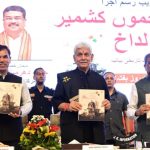Lolab Valley is also called ‘Wadi-e-Lolab’ or ‘Lolov,’ meaning the land of love and beauty. It stretches 25 to 35 kilometers from Kupwara to Diver Andarbugh in the northwest and Warnow Aafan in the southeast. The oval-shaped valley constitutes almost more than 40 small villages, with a population of around 1 lakh based on the 2011 census.
Rich in biodiversity, three-fourths of the valley is covered by forests, featuring an array of pine, deodar, and fir trees, along with diverse wildlife such as black bears, tigers, markhor, wild bulls, and musk deer. Despite its natural allure, Lolab lacks a Wildlife Sanctuary, National Park, and Bird Sanctuary, hindering its potential as a tourist destination.
To harness the tourism potential and preserve the natural beauty, the J&K government should prioritize forest conservation and promote forest tourism. Establishing a Tiger/Snow Leopard Conservation Centre and designating nature parks, rest houses, and forest huts will enhance the region’s appeal.
The Lolab Valley, characterized by hilly and mountainous terrain in the north, west, and east regions, serves as a Himalayan sub-valley, constituting the northwestern corner of the Kashmir Valley. Drained by the Lahwal River, locally known as Lalkul river, it is flanked by the Kashmir Valley to the south and the Neelum Valley to the north. Nagmarg Meadows separate it from Bandipora to the east. The Lolab Basin, shaped by the Lalkul river’s flow from east to west, is a distinctive geographical feature.
Originating from the heights of Nandmarg, Kimsar, and Bagalsar, north of Walur, the mainstream of Lolab spans approximately 30 km, flowing westward. The Kalaroos Nala, a lateral tributary, originates below the peak of Nalgat, converging with Lolab below Khumriyal. Before joining the Kahmil, sourced from ridges between Shamshbari in the west and Nowan Gali in the north, the Lahwal river is supplemented by the Haihom Kol from the north. Ultimately, the Lahwal River, in conjunction with the Kahmil River near Mughalpora, gives rise to the Pohru River.
The entire Lolab Valley is a treasure trove of natural wonders, offering picturesque landscapes and hidden gems like the renowned caves of Kalaroos and the serene Green Meadows. Lolab’s charm has been extolled by saints, poets, and philosophers for centuries. Satbarran Kularoos stands as a unique convergence of ancient and contemporary architecture, nestled on the outskirts of Madmadav village in the Kalarooch area.
The resting place of Saint Kashyap reshi, located in Lalpora village, provides a tranquil setting. Nearby, the Lavnag spring, with its crystal-clear water and three-foot depth, offers a serene spot. Gauri spring, another significant water source, adds to the natural beauty of the region. Some undiscovered tourist gems in the valley include the Nagmarg Camping Site, Chandigam, Warnow, Aafan, Machil, Kairwan Anderbugh, and more.
Recently honored with the Gold for Best Offbeat Destination in India at the prestigious Outlook Traveller Awards 2023, Lolab Valley beckons global tourists. While the people of Lolab extend a warm welcome to guests, the government needs immediate intervention for real development. Here are some immediate suggestions.
Road Connectivity
The only basic road connectivity facilities to the people in Lolab are not upto the mark as attraction for tourists. There is only one road connectivity with rest of the world. From Lolab to Srinagar it takes almost four hours to reach summer capital. The construction of road from Dardapora to Badipora and Chandigam to Sopore via tunnel or road became the alternative route with interconnection of three Districts i.e. Bandipora, Baramulla and Srinagar. It will reduce the distance from Srinagar to Lolab and Baramulla by almost 50 kilometers. Moreover, it will boost the regional economy and promote the tourism sector and will connect the Asia’s largest fresh Wular Lake and railway line.
Infrastructure and Safety Measures
Install Street Lights, across various locations in Lolab, to ensure the safety and security of tourists visiting the area. Establish Eco-Parks at several locations in Lolab, such as Putshai, Gagal, Warnow, Lalpora, Dardapora, Gungbuk, Sogam, Saiwan shalgund, Dorssa, and Kalaroose, to showcase the natural beauty of the region and promote eco-tourism. Improve Drainage Facilities along the roadsides to ensure better infrastructural maintenance. Construction of Tourist Huts for tourists to stay and immerse themselves in the natural surroundings will enhance their experience and encourage longer stays in Lolab. Road Widening of roads in the area for improved accessibility and convenience for tourists.
Tourist Attractions
Utilize Kaishan Ganga River for various purposes, and divert water from Machil area and Wular Lake for hydro-power generation, water sports, recreational purposes, and irrigation. This will have a multiplier effect on the economy and boost initiatives like homestays and enhance the natural beauty of Lolab.
Tourism Fund Management
Ensure judicious utilization of funds allocated for home stay assistance, promoting transparency and accountability. In a parallel effort to boost tourism and foster district development, the government approved a fund exceeding 50 lakh rupees in the fiscal year 2021-2022 for home stay assistance; only four out of the 60 applicants received half of the allocated funds. Despite the unutilized funds, the government did not seek an explanation from the head of the Tourism department regarding the lapsing of this financial allocation. This situation highlights a pressing need for increased scrutiny and accountability in managing public funds, ensuring that resources are utilized judiciously for the overall benefit of the community
The current guest houses at Diver Anderbaugh and Lalpora Lolab must be equipped with water and electricity infrastructure to enhance revenue streams. Furthermore, the Tourism Department should explore the installation of eye-catching signage at airports and key locations to attract tourists to Lolab Valley. Leveraging both print and electronic media, as well as social media platforms, can significantly amplify the promotional efforts. The Lolab Bangus Drangyari Development Authority should extend invitations to tour and travel agents for complimentary visits to Lolab, recognizing their pivotal role as catalysts for tourism growth.
It’s high time for Lolab Valley to step into the limelight as a world-class tourist destination. The concerted efforts of the government, coupled with the undying hospitality of the people, will undoubtedly pave the way for a more prosperous and harmonious Lolab Valley, where love, beauty, and untapped potential converge seamlessly.
(Dr. Mudasir Akbar Shah, King Fahd University Of Petroleum & Minerals Dhahra, Kingdom Of Saudi Arabia. Ex Lecturer & Senior Research Fellow, NIT Srinagar Kashmir. Ex Assistant Professor, Kombolcha Institute of Technology, Wollo University Ethiopia and Universiti Tenga Nasional Malaysia. President Civil Society Lolab; EK EHSAS. Email id: [email protected])









